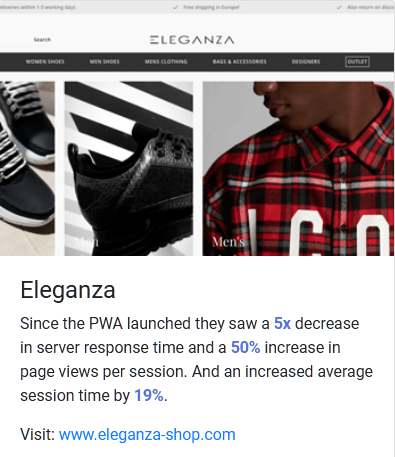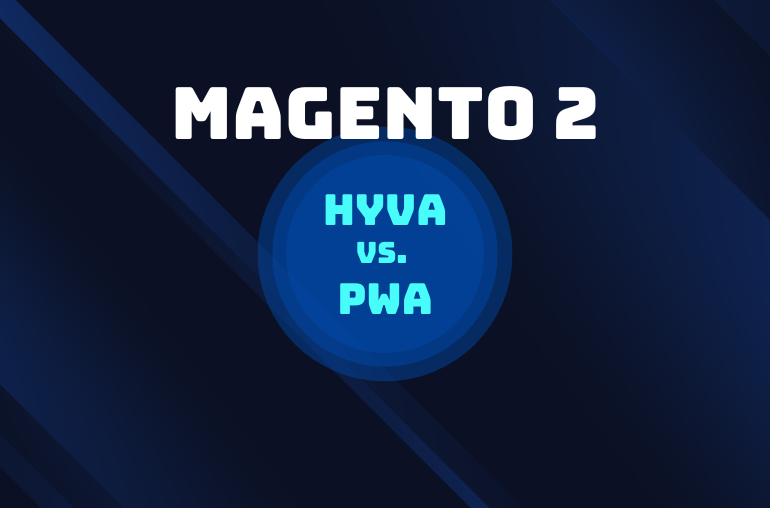Table of contents
Magento and PWA have been a thing for quite a while now, and word around is that it’ll soon be the new standard for eCommerce development. To best help you get started with this new standard of the web—and make it work to your advantage—today we’ll be showing you how you can properly integrate PWA into your Magento 2 store:
What is PWA?
Short for Progressive Web App, PWA is the new standard for web development as it brings to the Web an app-like, responsive experience, along with features previously exclusive to native apps.
But make no mistake: PWAs are still websites. They just look and feel like an app, thanks to modern web technology. This means that users will browse Progressive Web Apps on their browser with an URL just like they would do any website, but right after they land on the PWA, they get the experience of using an “app”, right on their browser, without the need to ever download and install an app.
Recommended reading: What is PWA? All you need to know about Progressive Web App
Magento PWA and why it’s better
Built with PWA Studio for the best compatibility with the Magento backend, Magento PWA is now the go-to way to deliver the best shopping experience for your shoppers. A Magento PWA storefront, when properly integrated, can result in as much as double performance uplift, along with other significant core metric growths such as boosts in your conversion rates, more time-per-session, etc.

From these results typically seen with PWA adoptions, we can see a pattern that PWA brings to the table experiences which customers have been craving for but have not been realized. And with the standardization of Magento PWA, you can be certain of the fact that you’ll only be seeing more of PWA-powered Magento stores from now on.
Ways to make your own Magento PWA
There are currently two ways to convert your existing Magento storefront into a PWA, each one with its own pros and cons:
Coding it yourself
For developers and merchants who feel the need to develop their own PWA-powered-storefront, Magento PWA Studio is a great tool for this purpose as it provides the best compatibility between your Magento 2 backend and your new PWA storefront. In fact, it’s the current de-facto tool for Magento PWA development since the community behind this open-sourced tool is huge, active, and always helpful.
However, there’s still a catch to Magento PWA Studio—it’s not a full-fledged solution, as it is instead a set of developer tools that allow you to build a PWA on top of your Magento 2 backend. And as with any other tools, you must be familiar with the programming language in use—that are ReactJS and GraphQL—as well as knowing the in and out of the Progressive Web App approach to web development in order to produce the best result.
Pros:
- Independent development
- Cost-saving
- More freedom to experiment with changes and designs
- Everything is your choice
- Big and helpful Magento PWA Studio community
Cons:
- Requires substantial coding knowledge and familiarity with the way the Web works
- Slow time-to-market which can be seen as an opportunity lost
- Everything is not guaranteed to work
In case you’re thinking of doing it yourself, we’ve prepared a guide for you here which will show you the installation process of Magento PWA Studio
Hiring professional help
This is often the preferred choice for most Magento merchants out there as Magento 2 PWA is still a relatively fresh approach to the Web, and not everyone feels comfortable building a storefront without the help from professionals who are equipped with years of experience in developing storefronts optimized for increasing your conversion rates and overall user experience.
With a professional team to handle your project, you can be certain of the fact that everything will be delivered on-time and your PWA is handled with the care and the attention that it deserves. However, PWA-building projects are often costly and require clear communication between you and the service provider(s) for a satisfactory result.
Pros:
- Trusted professional service providers with years of experience to handle your project
- Guaranteed performance uplift and full functionality
- Better overall user experience with more optimizations applied on the frontend to improve conversion rates
- Faster time to market
Cons:
- Costly
- Requires clear and proper communication (especially regarding your requirements and your needs) between you and the service provider(s)
Related article: How much does it cost to build a PWA for Magento?
Conclusion
While it might sound tempting to try building a PWA version of your storefront, it’s not a good idea most of the time. Experienced solution providers can do the job for you and waste less time while doing so, leaving you with more rooms to plan your future initiatives for your store.
Here in SimiCart, we believe PWA is the future of the web, and we have a good team of developers with over 9 years of experience behind us to ensure that your store can get the best from this newfound technology.




